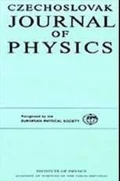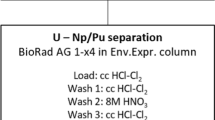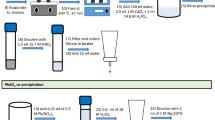Abstract
A sequential extraction technique was developed and tested for common naturally-occurring radionuclides. This technique allows the extraction and purification of uranium, thorium, radium, lead, and polonium radionuclides from the same sample. Environmental materials such as water, soil, and biological samples can be analyzed for those radionuclides without matrix interferences in the quality of radioelement purification and in the radiochemical yield. The use of isotopic tracers (232U, 229Th, 224Ra, 209Po, and stable lead carrier) added to the sample in the beginning of the chemical procedure, enables an accurate control of the radiochemical yield for each radioelement. The ion extraction procedure, applied after either complete dissolution of the solid sample with mineral acids or co-precipitation of dissolved radionuclide with MnO2 for aqueous samples, includes the use of commercially available pre-packed columns from Eichrom® and ion exchange columns packed with Bio-Rad resins, in altogether three chromatography columns. All radioactive elements but one are purified and electroplated on stainless steel discs. Polonium is spontaneously plated on a silver disc. The discs are measured using high resolution silicon surface barrier detectors. 210Pb, a beta emitter, can be measured either through the beta emission of 210Bi, or stored for a few months and determined by alpha spectrometry through the in-growth of 210Po. This sequential extraction chromatography technique was tested and validated with the analysis of certified reference materials from the IAEA. Reproducibility was tested through repeated analysis of the same homogeneous material (water sample).
Similar content being viewed by others

References
UNSCEAR (2000). Sources and Effects of Ionizing Radiation. United Nations Scientific Committee on the Effects of Atomic Radiation. UNSCEAR 2000 Report to the General Assembly, Vol. I. United Nations, New York.
Bojanowski R., Fukai R., Balestra S., and Asari H.: In: Proceed. of the 4th Symposium on the Determination of Radionuclides in Environmental and Biological Materials. Laboratory of the Government Chemist, London, Paper No. 9 (1983).
Holm E.: Int. J. Appl. Radiat. Isot. 35 (1984) 285]
Horwitz E. P., Dietz M. L., Chiarizia, R., and Diamond, H.: Analytica Chimica Acta 266 (1992) 25.
Carvalho F. P.: The Science of the Total Environment 196 (1997) 151.
Carvalho F. P. et al.: In: Proceed. of an International Workshop on Environmental Contamination from Uranium Production Facilities and Remediation Measures, Lisbon 11–13 Feb. 2004, p.41. International Atomic Energy Agency, Vienna, 2005.
Carvalho F.P., et al.: In: Uranium in the Environment: Mining Impacts and Consequences. B. J. Merkel and A. Hasche-Berger Eds., p. 691. Springer-Verlag Berlin Heidelberg Publ. (2006).
Eichrom: Analytical procedure for the determination of Americium, Plutonium and Uranium in Water. Eichrom Industries Inc., Analytical Procedures, UK, Ref. ACW03 Rev 1.5, (1995).
Talvitie N.A.: Analytical Chemistry 44 (1972) 280.
Roman D.: Int. J. Appl. Isot. 35 (1984) 990.
Hanckok G. J. and Martin P.: Appl. Radiat. Isot. 42 (1991) 63.
Results of the 2001/02 Intercomparison Exercise on Determination of the Quantity Activity of Alpha Emitters in Urine Samples. IAEA Division of Radiation and Waste Safety, Radiation Monitoring and Protection Services Section, Report on Exercise PROCOSTAT 2000. International Atomic Energy Agency, Vienna, 2003.
Pham M., La Rosa J., Lee S.H. and Povinec P.: IAEA-414, Radionuclides in Mixed Fish from Irish Sea and the North Sea. International Atomic Energy Agency, Monaco Report IAEA/MEL/73 (2004).
Pham M. K., Sanchez Cabeza, J. A. and Povinec, P. P.: IAEA-385, Radionuclides in Irish Sea Sediment. International Atomic Energy Agency, Monaco Report IAEA/MEL/76 (2005).
Author information
Authors and Affiliations
Rights and permissions
About this article
Cite this article
Oliveira, J.M., Carvalho, F.P. Sequential extraction procedure for determination of uranium, thorium, radium, lead and polonium radionuclides by alpha spectrometry in environmental samples. Czech J Phys 56 (Suppl 4), D545–D555 (2006). https://doi.org/10.1007/s10582-006-0548-x
Issue Date:
DOI: https://doi.org/10.1007/s10582-006-0548-x



